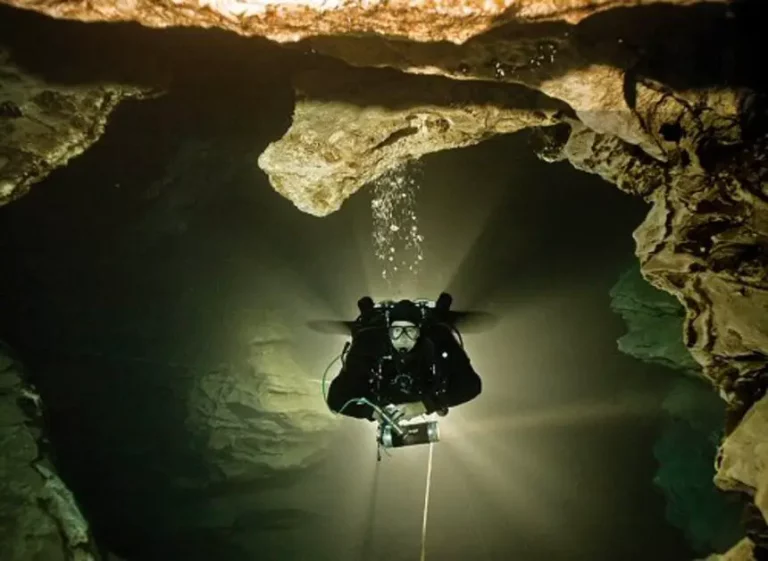
One of the worlds most impressive cave-systems lies beneath a European capital city, and its potential for exploration grows bigger by the week. There were many surprises in store when Dmitri Gorski decided to spend a long weekend in Hungary.
NOT MANY CAVE SYSTEMS in the world have a fashionable downtown address. This one does. Look it up in Yellow Pages! The address is Frankel Léo út. 48, Budapest, Hungary.
Right in the middle of a metropolis, tunnels burrow their way through soft limestone in all directions.
The entrance is behind a low fence, near a ruined Turkish bath-house that looks as if it was built 1000 years ago. The spring was already in use in the 11th century.
Divers have been exploring the Molnár János cave system for years.
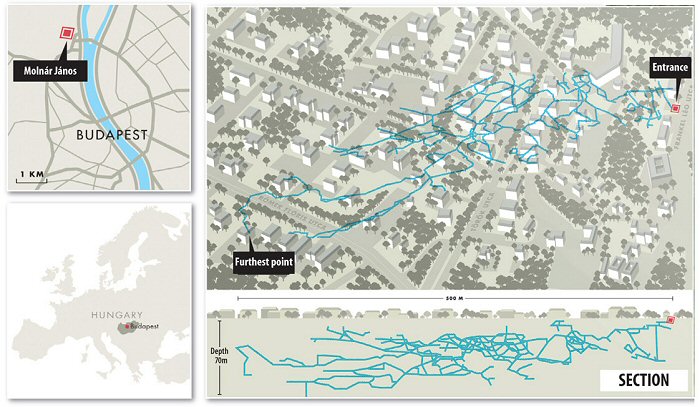
The tunnels are a maze, irregular and shifting. from huge rooms to tight restrictions and vertical cracks.
An intricate network of finger-thick ropes has been installed over time.
It can be navigated using big line arrows at every intersection, but without a local guide it’s a hopeless and even dangerous adventure.
A large number of circuits and complicated junctions are offered through the irregular shape of the system.
Ropes are there to pull on when passing the many restrictions; a classic thin guideline would have been ripped to shreds on sharp stone edges long ago.
Diving in Molnár is a very special experience; join me on a trip of urban overhead exploration in the ancient capital of Hungary!
Zsolt Gyurka started cave-diving in 1981, a year before I was born. He has been exploring the Molnár cave for some 11 years, and is one of Hungary’s most experienced cave-divers.

It was he, some five years ago, who found a small passage connecting the old Molnár János system, which was only about 200m long, to the new one.
The cave was discovered around 1860 by a pharmacist named Molnár János (the first name is always written last in Hungary).
He analysed the water and the dry area and concluded that a great mass of water must flow into the Danube here. Diving started only many years later, in the 1950s.
THOSE WHO SAY THAT THE COLOUR of real cave-divers is black should get out and do some more diving. The right answer is pink!
It takes time to turn a new piece of equipment pink. Red is easy; my red Agir wing is pink after some 400 dives with it. Blue is tougher, but Zsolt`s once-blue drysuit is almost there.
He is old-school, with tucked long-hose and independents – and after more than 1400 dives, he knows Molnár János like his own backyard.
We were in good hands, and would see many seldom-visited places over a spring weekend.
I was diving with Zoltan (a Hungarian friend from Finland) and Belgian couple Erik and Isolde, two of us on closed-circuit and the others on twin-sets.
It’s hard to complain about the diving conditions in Molnár. The water comes from thermal springs deep in the Earth’s crust, and water temperature is 25 and 19° in the two different thermoclines present.
Like the cave itself, they seem to follow no logical pattern. The temperature randomly rises and falls in different parts of the system.
Gloves are not necessary but are a good idea, with all the tight restrictions through which you need to pull yourself to reach the wider areas.
The water here eats up chrome-plating on regulators and rubber seals.
A lot of equipment is rendered useless after a period of time.
Sulphur and carbon dioxide are the culprits. Thermal springs deep beneath the city carry hydrogen sulphide up, and the pH of the water drops as sulphuric acid is formed.
In addition, carbon dioxide dissolving in the water forms carbonic acid, making the water an acidic cocktail.
That is also why the cave’s limestone is so porous. The walls are like a sponge; touch anything and it will shatter into 100 pieces.
A THICK LAYER OF CLAY covers the floor. Limestone dust rains down from the ceiling, even if you don’t disturb it with your fins. Exhaust bubbles are sometimes enough to reduce the visibility remarkably.

This is also why normal tie-offs are impossible here – they would come undone, and take a piece of limestone with them.
That the whole cave is like Swiss cheese can probably be explained by the aggressive water, but the material density and composition in different parts must vary a lot.
The flow of water in the cave is almost zero, but the general direction is into the Danube river.
Water always finds the easiest way to eat through rock, and scientists think the Molnár cave was created by chemical dissolution, rather than mechanical dissolution achieved by the flow of water itself.

All the tie-offs are done by driving a long screw deep into the walls, a metal shackle on it holding a line loop where a mainline is later secured. It’s a slow, cumbersome process.
There is no mung, no organic sediment, no fish. A few tiny white isopods are all that survive in the acidic water.
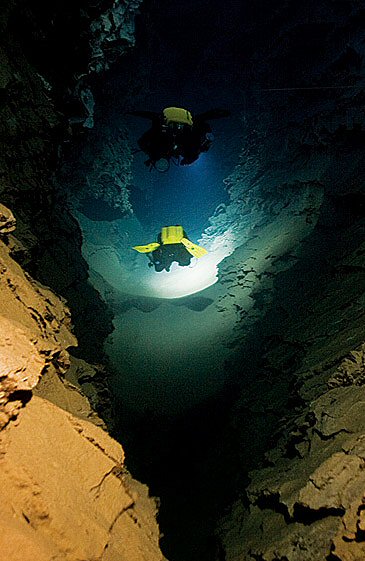
Sometimes you see blades and other metal objects screwed to the walls with a note saying: “Don’t touch, belongs to me”.
These are placed here by divers because within a couple of months they will look rustic and worn.
You may find one of these artefacts in Budapest’s central market if you’re looking for an ancient Turkish sabre as a souvenir…
ALMOST EVERY DIVER visiting Molnár stays at a hotel in Buda called Császár. It’s cheap and convenient, as the cave entrance is only 100m down the street.
We walked there early in the morning the day after we arrived. The weather was surprisingly warm at 20°, and it was sunny.
Cave-instructor Zsolt handles everything professionally. We analysed the nitrox tanks he had prepared for us.
The cave entrance used to be in a small pond, but a few years ago the nearby hospital spa installed a pipe to pump the water across the street for medical purposes.
The small passage became impossible to swim through, even with side-mounts, and a new entrance had to be made.
Nowadays you enter the cave system by ladder through what seems like an old basement. The passage is very tight at first, hard to fit through with twins and stages.
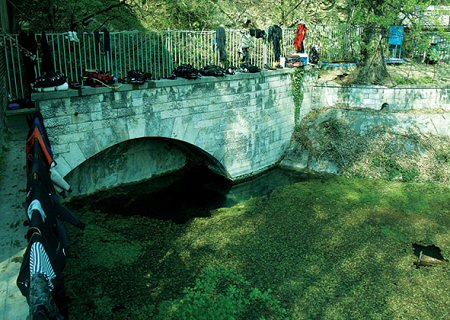
To reach the entrance to the system itself, you have to swim some 10m through a narrow rift.
Finally you see a thick electrical cable going towards a small side passage at the bottom of the rift. This leads the way to the mainline.
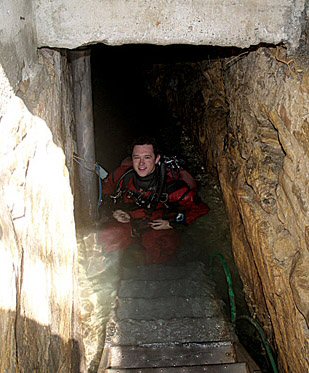
You drop to the bottom and crawl along the cable until it connects to a rope.
The next 100m or so consists of tight cracks and several restrictions where you may have to go head down. This is the old part, the cave as it was known until only some six years ago.
A small passage in the corner in one of the rooms goes down sharply and than turns. Enter it head-down, wriggle through until it widens and you are in the new Molnár.
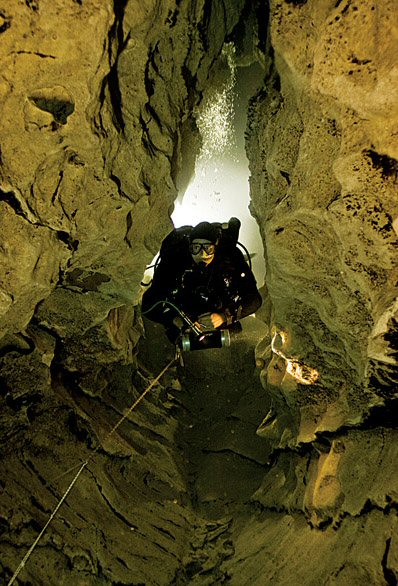
The old part of the cave consists of about 500m of passages, but the new part covers more than 5000m, and new line is added all the time. Maximum explored depth today is about 90m.
All exploration is carried out on open-circuit, and scooters have come into use only recently.
Already on this first dive we were amazed by the cave’s diversity.
Limestone is usually bright white, but here we saw all shades of grey, and even black walls.
Zsolt explained that the black came from manganese oxide, dissolved in the thermal mineral water and crystallised on the white walls.
EXPLORERS HERE WORK CLOSELY with Budapest university, where chemists analyse the cave’s minerals and water.
A few minerals have been found in here. One, a previously unknown crystal form of calcite, still puzzles the scientists.
Here and there on the walls are areas covered with fine crystals. These reflect the light, sending it all through the cave. The crystals are often barium sulphate.
Traces of explorations and scientific activity are everywhere. At many intersections there are sealed plastic cola bottles containing thermometers.
Why not just place the instruments in the water I asked Zsolt later.
He explained that temperature equilibrium was achieved inside the bottle over time.
If the thermometer was unprotected, divers coming to read it would stir the water around it and risk an incorrect read-out.
After two dives in Molnár, Zsolt had something special in mind for us. We loaded our gear into his minibus and drove through the busy centre of Budapest, filled with tourists enjoying the warm weather.
We passed through residential streets, then red-brick industrial buildings started to appear.
We stopped at a gate.
A sleepy guard recognised Zsolt and let us into a factory yard with red walls on both sides and tall chimneys rising to the sky.
Zsolt opened two or three more gates with his own keys, and we drove into and stopped in a white-walled basement under a massive building.
We prepared our equipment and waited, baffled, until we saw Zsolt driving a small electric car with a trailer, the sort used at airports to carry luggage.
The tunnels ahead were too small for a standard car, he told us.
The site we came to was Köbánya, or “Stone Mine”. We were going to dive in a 1000-year-old limestone mine!
The Sala and Tuna mines back home in Sweden, which I had considered ancient, suddenly seemed a lot more modern.
Zsolt drove confidently through a maze of tunnels that grew increasingly narrow. Electric wall-lights installed by the divers flickered into life, awakened by motion sensors.
Finally, he stopped and pointed at a small door in one of the walls – our entrance.
We kitted up and went down a staircase. Suddenly water was splashing under our feet! We hadn’t even noticed the surface, the water was so clear.
WE DID OUR CHECKS and continued down the corridor, this time with regulators in. The temperature was much lower than in the thermal caves, about 12°C.
The stairs went down to about 15m deep, and from there a long corridor started. There was a wooden floor in the middle, but on either side of it the corridor continued down into darkness, depth unknown.
We reached a huge room with a spiral staircase in one corner and a big open hatch in the middle, a workshop.
Some wheeled carriages stood in the room, but only foundations in the centre, on which machines had once rested.
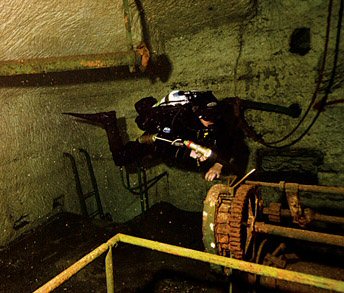
Zsolt later told us that the mine had operated until the 18th century, after which a brewer used parts of it as a warehouse.
In WW2, Messerschmitt fighter-engine parts were made here by the Germans. Now abandoned, this is a popular diving destination for technical divers from all over Hungary and beyond.
Zsolt had his own compressor and gas bank there.
Zsolt knew we would like the Köbánya mine, but the second day in Molnár would be even more special.
“You’re good divers; today I will show you one of the areas that we currently explore!” he told us that morning.
We prepared the gear. We knew that the dive would be quite long, and we needed two bottom-gas stages apart from the twins on our backs.
Our route took us through the familiar section to a new area through a restriction. Visibility is much better in those parts of the cave seldom visited by guest-divers.
The passages also became bigger, sometimes opening into huge vaults tens of metres deep.
In one place, we had to pass under the roof of such a vault and couldn’t see the bottom. Later Zsolt told us it was at around 55m – we had been at 40.
Then the cave started to get shallower, and we entered an area where we could see that active exploration was going on.
Big drums of rope hung on the main line here and there. When we explore, we usually mark the distance by knots, but with finger-thick ropes this would not be practical.
Instead, clothes pegs had been used to mark every metre of distance. Incredibly accurate maps are generated on computer using the measurements.
Zsolt had once tested the accuracy of the map by driving a drill into the rock at street level, at a point where he had calculated that the cave came up to only a metre below.
He then did a dive there. The drill bit was found sticking out under water in the cave tunnel, only a metre from the point at which he was aiming!
I had an unpleasant experience as we descended into the deep part of the cave on our way back.
I felt I couldn’t equalise my right ear, and momentarily imagined myself stuck more than a kilometre into the system, an hour from the entrance, with what for me would be inaccessible deep passages blocking my way.
I signalled the team to slow down, went up a couple of metres and the block shot through like a cannonball and everything cleared.
Cave-diving can be a bit too exciting at times, but the long swim to the exit proceeded without further problems.
ZSOLT WANTED TO SHOW US one more remarkable place before we left – a huge vault deep inside the cave system, with walls as black as night.
The blue rays from our lamps seemed to be absorbed into them, never to return.
Towering all around us, the walls seemed as indestructible as those of an ancient magic castle.
However, the slightest touch would remove the colour in an explosion of blackness, revealing bone-white limestone beneath.
The manganese oxide layer had been deposited on the walls over centuries, brought up by mineral water from deep inside the Earth.
Incredibly beautiful and fragile, the room could easily be lost forever to careless divers.
Zsolt saved this for the last moment, when he was confident that we would not disturb the beauty of Mólnar János.
Zsolt is not just a great diver, he is the guardian of a great treasure!
